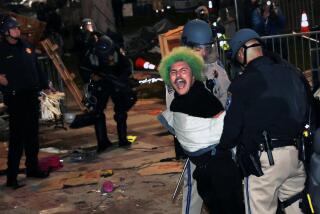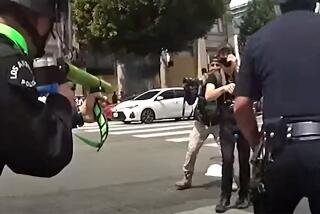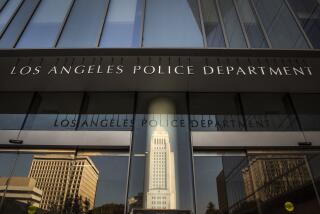Ruling Could Limit Police Use of Pepper Spray
- Share via
Police use of pepper spray to subdue nonviolent protesters may be an unconstitutionally “unreasonable use of force” in some circumstances, a federal appeals court ruled Thursday.
The ruling, in a case growing out of protests against logging in the Headwaters Forest area in Northern California, does not ban the use of pepper spray. But the decision by the U.S. 9th Circuit Court of Appeals indicates that there are limitations on when it is appropriate for use by law enforcement.
The ruling could influence police tactics statewide at a time when Los Angeles police are preparing to handle protests at this summer’s Democratic National Convention.
The ruling stemmed from actions by Humboldt County law enforcement officials during a series of protests in the fall of 1997. Sheriff’s deputies used cotton swabs to dab pepper spray into the eyes of several demonstrators who were trying to stop Pacific Lumber Co. from cutting huge, old-growth redwood trees. In addition, some officers sprayed the caustic chemical into the eyes of protesters from close range.
A federal district judge in San Francisco dismissed a civil rights suit filed by the protesters against the Sheriff’s Department, the Eureka Police Department and seven individual officers. But the unanimous ruling by a three-judge panel of the 9th Circuit in San Francisco has revived the case--meaning that the nine plaintiffs will get to take their case to a jury and that they can seek punitive damages.
The 4th Amendment to the Constitution allows police to use only as much force as is “reasonable” to make an arrest, the appeals court judges noted. “The evidence suggests the protesters suffered excruciating pain” from the use of the pepper spray, and because the protesters posed no danger to anyone at the time, a jury should decide if that amount of force was unreasonable under the circumstances, the panel said.
“This was a shocking case,” said Margaret Crosby of the American Civil Liberties Union of Northern California, who filed a brief on behalf of the plaintiffs. “The Humboldt sheriffs used pepper spray as a kind of chemical cattle prod on nonviolent protesters.”
The ruling is “an important decision” for police handling of large demonstrations, said veteran Santa Monica civil liberties lawyer Carol Sobel.
LAPD Cmdr. Thomas Lorenzen, who is coordinating security for the Democratic National Convention, said that although he had not seen the court decision, he was familiar with the Humboldt protests. “We do not use pepper spray on nonviolent protesters and we would not,” he stressed.
Nancy K. Delaney, the Eureka attorney who represented the Humboldt law enforcement agencies, said she would seek a review of the ruling by a larger panel of 9th Circuit judges, but had no further comment.
Use Has Risen in Last Decade
Mark Hughes of Earth Law, a Denver-based public interest group that represented the plaintiffs, said, “People of whatever political persuasion ought to be happy that the police cannot apply excruciating, severe pain to nonviolent protesters.”
The use of pepper spray by law enforcement agencies and by civilians attempting to protect themselves from attacks by muggers has increased significantly during the past decade. By some estimates, up to 90% of the nation’s police departments--including Seattle’s during the recent protests against the World Trade Organization--have used pepper spray to disperse demonstrators.
In 1995, the American Civil Liberties Union of Southern California issued a lengthy report on what it described as excessive, abusive use of the potent chemical, which is formally known as oleoresin capsicum aerosol, or OC.
Along with tear gas, pepper spray is banned from use in war by an international treaty. However, when employed by police agencies in the United States, its use is not governed by a regulatory agency. It is considered sufficiently dangerous that the 9th Circuit previously ruled that when pepper spray is used in the commission of a felony it is considered a dangerous weapon that is a factor in enhancing a sentence.
The ACLU of Northern California filed a friend-of-the court brief in the Headwaters case, focusing on the health effects of pepper spray. Studies have shown that it can cause temporary blindness, diarrhea, respiratory problems, vomiting and disorientation.
Thursday’s decision arose out of three protests in the fall of 1997, as environmental activists protested the Headwaters Forest agreement between Pacific Lumber and the U.S. government. The agreement permitted the huge timber company to increase logging of old-growth redwoods in exchange for selling 7,400 acres of forest, which eventually was purchased jointly by the state and federal governments for $480 million.
In the first incident, on Sept. 27, 1997, seven protesters staged a sit-in at Pacific Lumber’s Scotia headquarters. They linked arms through 10- to 25-pound steel tubes called “black bears,” which prevent officers from applying pressure to separate them. When the protesters refused to disperse, the officers swabbed pepper spray into the eyes of four protesters, who “screamed in pain,” according to the decision, written by 9th Circuit Judge Harry Pregerson. The three other protesters, including one who had asthma, then voluntarily released themselves from the steel tubes.
The second demonstration came a week later when two sets of protesters, also using black bears, locked themselves to two Pacific Lumber bulldozers at a remote logging site. The same deputy sheriff was called to the scene. He testified at a hearing that he told the protesters that officers would use pepper spray if they did not release themselves from the steel tubes. He also said he felt that this was safer than using a grinder to break through the self-locking devices.
Pregerson said that in both incidents, the officers “made no attempt to negotiate with the protesters. They simply threatened repeatedly to use pepper spray.” Two of the protesters complied, but two others refused.
“The officers applied the pepper spray with a Q-tip to the closed eyes of both protesters,” Pregerson wrote. “Despite the protesters’ pleas for water to flush the pepper spray out of their eyes, one of the officers can be heard on the videotape saying that they will only be given water if they release and that the pain will only get worse in 30 seconds when he sprays the OC in their faces. A minute later, he sprayed the OC directly into both of the protesters’ faces in short full bursts from inches away. The videotape reveals that the blast of pepper spray ran down one protester’s face and into his mouth.”
Authorities used the spray two weeks later against demonstrators who were staging a sit-in at the Eureka office of then-Rep. Frank Riggs (R-Windsor).
Nonviolence of Protesters Noted
The 9th Circuit decision repeatedly emphasized the nonviolent nature of the protest in assessing whether it was proper for the authorities to use pepper spray. At a hearing before U.S. District Judge Vaughn R. Walker in San Francisco, “even Sheriff [Dennis] Lewis conceded . . . that no law enforcement officer in Humboldt County, the state of California, or anywhere in the nation had ever used pepper spray on nonviolent protesters as it was used in this case.”
Nonetheless, Judge Walker found the officers’ conduct reasonable, saying that “the severity of the intrusion on arrestees’ personal integrity was minimal.”
Pregerson, joined by Judges William A. Fletcher and Myron H. Bright, disagreed on that point and on all the other key legal issues. The judges said that the protesters posed no danger to anyone and that the officers were not responding to a dangerous situation in which they would have had to make a split-second decision.
“No evidence in the record suggests that the protesters here attempted to inflict pain or serious injury on the arresting officers,” the 9th Circuit judges wrote.
More to Read
Sign up for Essential California
The most important California stories and recommendations in your inbox every morning.
You may occasionally receive promotional content from the Los Angeles Times.













